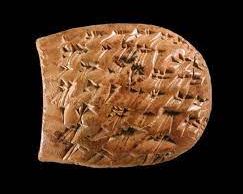The shipment of 1,100 ancient Achaemenid-era clay tablets The tablets have now been transferred to the National Museum of Iran and will be publicly displayed in two weeks, according to the Ministry of Cultural Heritage.
While the repatriation has been dubbed by domestic Iranian media as Pezeshkian's "souvenir", it holds deep significance for Iranians, reconnecting the country with its ancient pre-Islamic heritage, nearly 1,000 years before Islam, and offering invaluable insights into the Persian Empire’s administration and daily life.
The Elamite cuneiform inscriptions were discovered by an archaeological team from the University of Chicago, led by renowned archaeologist Ernst Herzfeld, during the excavation of Persepolis (Takht-e Jamshid), the ceremonial capital of the Persian Empire, in the 1930s.
These clay tablets, written in cuneiform script, belonged to the Persepolis Fortification Archive, which held records from a single administrative organization around 500 BC and consisted of tens of thousands of fragile clay fragments.
The records provide a wealth of information about the lives of royals and ordinary working people, including women who served the royal household or worked as artisans, detailing their wages and rations, which were paid in silver or commodities such as wine, beer, and grains.
They also reveal the use of a highly effective accounting system. Many of the clay tablets were sent to the Persepolis archive from other regions of the Persian Empire for safekeeping, offering great insight into the empire’s vast history and transportation networks.
In 1935, the Iranian government loaned 30,000 pieces of the tablets to the University of Chicago’s Oriental Institute for three years to be reconstructed and deciphered. However, due to the complexity of the work and the fragile nature of the tablets, they remained at the institute until 1948, when the first batch, including 150 pieces, was returned to Iran.
The course of Iranian governance took a dramatic turn approximately 31 years later with the Islamic Revolution of 1979, which resulted in the establishment of a theocratic Islamic state, replacing the monarchy of the Shah.
In 2001, during the presidency of Mohammad Khatami–who is labeled by some as a reformist– another 300 inscribed tablets were repatriated after being fully pieced together, translated, and digitally cataloged. Another 300 tablets followed in 2004.
After this shipment, a legal dispute emerged from a group of Americans, seeking to collect on a $423.5 million judgment awarded to them as damages. They had sued the Iranian state, demanding the seizure and auction of the tablet collection as compensation.
The plaintiffs, victims of a 1997 Hamas bombing in Jerusalem, claimed Iran was responsible for the attack due to its ties with Hamas and argued that the tablets were commercial property of the Iranian government that could be sold as antiques. In 2006, a US federal court ruled in their favor.
After years of legal battle, a US court of appeals in Chicago rejected the request for the tablets' seizure in 2011. The plaintiffs continued to challenge the ruling until 2018, when the US Supreme Court upheld the appeals court decision.
As a result, the University of Chicago repatriated two more collections, including over 5,000 tablets, in 2019 and 2023. Some of these tablets are now on display at the Persepolis Museum.
The tablets are inscribed in Elamite, a language spoken in the ancient kingdom of Elam in southwestern Iran and during the Achaemenid period (559 BC to 331 BC). Elamite, unrelated to any other ancient or modern language, became extinct around 400 BC.
The language was recorded in pictographic, figurative, and later cuneiform characters from the middle of the 3rd millennium BC. Elamite served as one of the official languages of the Persian Empire, alongside Old Persian and Akkadian.
Iranian Elamitologist Abdul-Majid Arfaee (born 1939) has translated over 2,500 of these documents. Arfaee, who studied under American Elamologist and Assyriologist Richard Hallock at the University of Chicago in the 1970s, founded the Inscriptions Hall at the National Museum of Iran to house part of the collection returned to Iran in the 1980s.











